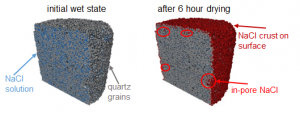ISTO, UMR 7327,
Univ Orléans, CNRS, BRGM, OSUC, F-45071 Orléans, France

- Cet évènement est passé
Séminaire invité de Hannelore Derluyn, CNRS (LFCR UMR 5150, Univ Pau & Pays Adour)
4 décembre 2018 - 13 h 30 / 14 h 30
Navigation Évènement
Unravelling salt crystallization dynamics in rock by X-ray tomography

Salt crystallization causes major weathering of building stones and landscapes, affects the salinity of soils, and the permeability of rocks. When saline fluids are present in the pore space of a material, salt crystals might precipitate upon changes in temp erature or humidity conditions, leading to salt precipitation on the surface, efflorescence, or to salt crystals precipitating in the pores, subflorescence, which might clog the pores. The confined crystal growth within the pores might lead to a buildup of crystallization-induced stresses, which can eventually induce cracks in the porous medium. The cracking thus results from the coupling between saline flow, salt precipitation reactions and crystallization-induced stresses. Theoretical and numerical models have been developed to describe this coupling, and experiments have been conducted on model porous media (e.g. in sand or glass beads packs, and model capillaries) to elucidate on the dynamics at play. Direct experimental studies in geomaterials of the governing processes at the pore scale are however limited.
X-ray tomographic imaging has proven to be a well-suited technique for studying pore-scale dynamics in rock. I will illustrate its potential for research on salt crystallization in porous media and the data that can be extracted through quantitative image analysis by presenting two case studies.
A first study focuses on the kinetics of drying and deliquescence, and on the concomitant kinetics of salt precipitation and dissolution of halite crystals within the pore space of Mšené sandstone. Mšené sandstone samples of 8 mm in diameter were initially capillary-saturated with a saturated NaCl-solution and subsequently dried at 50% RH and at 20% RH, at room temperature. At 50% RH, a constant drying rate and a constant salt growth rate is found during the full drying period. At 20% RH, the dynamics of the formation of a salt skin are quantified, partially closing the pores and causing a slower drying during the continuation of the process. Subsequent humidity cycling between 80% RH and 20% RH causes a migration of the salt into the subsurface, which is coupled to changing drying kinetics with respect to the first drying of the sample. By coupling the image segmentation analysis with the pore network characteristics of the scanned rock, drying/deliquescence and precipitation/dissolution events for each individual pore are quantified and the link with the pore network’s connectivity is made. A second study focuses on cracking induced by localized NaCl-precipitation in Savonnières limestone. A capillary-saturated sample, of 8 mm in diameter, is subjected to one drying (20% RH) deliquescence (80% RH) cycle. During drying, tensile strains develop as quantified by digital volume correlation of the X-ray scan-series of the drying process. Thanks to the high spatial resolution of the scans, the crack path, crack initiation and propagation, can be linked to the structural features of the rock. During deliquescence, the tensile strains reduce, leading to a partial closure of the cracks and illustrating the dynamic nature of precipitation- dissolution induced cracking.


